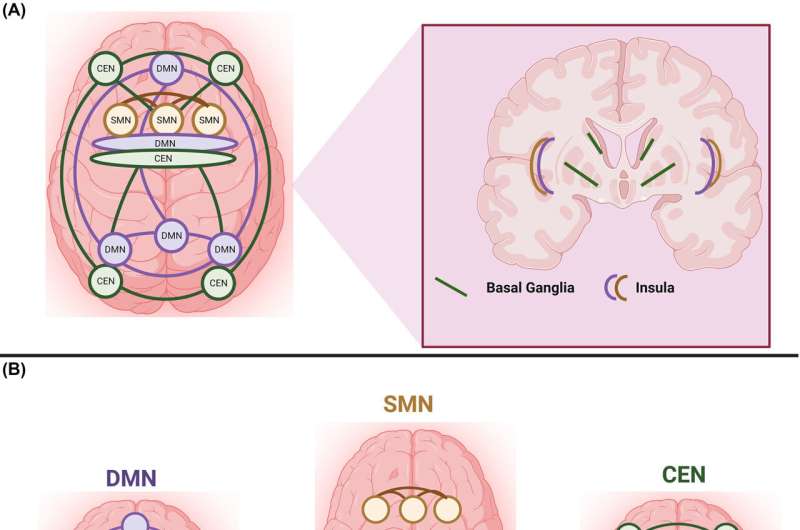
Schematic overview of the three creative network models. (A) Localization of the default mode network (DMN, purple), the salience mode network (SMN, brown), and the central executive network (CEN, green); and (B) The fundamental functions of each network model, which are described in the boxes below each model. The arrows refer to the interactions between these models based on their functions. Credit: CNS Neuroscience & Therapeutics (2023). DOI: 10.1111/cns.14266
Can creative therapies help with neurodegenerative diseases, such as stroke and Alzheimer’s disease? Neurobiologist Dr. Radwa Khalil of Constructor University in Bremen and Prof. Vida Demarin, former director of the International Institute for Brain Health in Zagreb, Croatia, have recently published an article presenting their results addressing this question.
The concept of brain plasticity pertains to modifications in the neural pathways of the brain and refers to the changes that usually arise in response to various factors, such as training-induced behavioral alterations and physiological processes like maturation or brain injuries. Khalil and Demarin are researching how to improve plasticity through creative therapies related to neurodegenerative diseases such as stroke and Alzheimer’s disease.
In their article, “Creative therapy in health and disease: Inner vision,” now published in the journal CNS Neuroscience & Therapeutics, the authors deal with creative therapeutic approaches such as painting, music, sport, and dance. “Creativity is more than creating novel, surprising and useful solutions,” Khalil said. “The neuroscientific approach to examining the relationship between creativity and health is frequently disregarded. Creative therapy can help patients compensate for their cognitive impairments by expressing their hidden talents.”
Dr. Radwa Khalil, Postdoc in Neurosciences at Constructor University in Bremen. Credit: Constructor University
At the same time, the authors identify a number of central questions that require further research. “Despite the current development in the research on the neuroscience of creativity, it is still in the shadow compared to other research domains. Progress in this research domain demands further empirical studies,” said Khalil.
More information:
Radwa Khalil et al, Creative therapy in health and disease: Inner vision, CNS Neuroscience & Therapeutics (2023). DOI: 10.1111/cns.14266
Provided by
Constructor University
Citation:
Examining whether creative therapies can help with neurodegenerative diseases (2023, June 22)
retrieved 22 June 2023
from https://medicalxpress.com/news/2023-06-creative-therapies-neurodegenerative-diseases.html
This document is subject to copyright. Apart from any fair dealing for the purpose of private study or research, no
part may be reproduced without the written permission. The content is provided for information purposes only.
>>> Read full article>>>
Copyright for syndicated content belongs to the linked Source : Medical Xpress – https://medicalxpress.com/news/2023-06-creative-therapies-neurodegenerative-diseases.html
